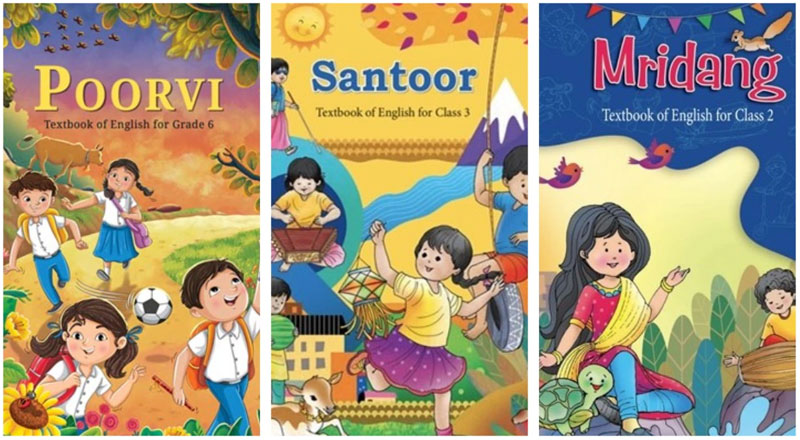A New Naming Strategy Raises Old Questions
The National Council of Educational Research and Training (NCERT), India’s apex body for curriculum development, has recently stirred a national conversation by assigning Hindi titles to English-language textbooks, including those meant to teach English. Titles like Poorvi, Mridang, and Santoor now adorn English textbooks for Classes 1 through 7, a move that has raised eyebrows and ignited a linguistic and cultural debate.
This naming convention marks a break from the NCERT’s long-standing practice of matching a book’s title with its medium of instruction. For instance, until recently, Class 6 and 7 English textbooks were known as Honeysuckle and Honeycomb. Now, they’re both called Poorvi—a Hindi term meaning “eastern,” also associated with a classical Indian raga.
Critics argue that this shift is symbolic of a broader cultural imposition, especially given the political backdrop of India’s multilingual fabric and ongoing resistance from several southern states to the Centre’s three-language policy.
NCERT and Its Role in Shaping Indian Education
Established in 1961, the NCERT functions under the Ministry of Education, guiding and coordinating curriculum standards across schools affiliated with the CBSE board. It plays a key role in implementing national policies like the New Education Policy (NEP) 2020, which emphasizes integrating Indian knowledge systems, culture, and values into the curriculum.
Under NEP 2020, the NCERT began rolling out new textbooks starting in 2023. Textbooks for Classes I and II were launched first, followed by Classes III and VI in 2024. The latest rollout includes Classes IV, V, VII, and VIII, where the Hindi naming trend continues.
While these changes aim to reflect India’s cultural heritage, the use of Hindi titles—especially in English-medium books—has created confusion and raised concerns of linguistic bias.
Breaking with Tradition: A Cultural and Linguistic Controversy
Traditionally, NCERT has provided distinct titles for textbooks in different languages. For example, the Class 6 Mathematics book was previously titled Mathematics in English, Ganit in Hindi, and Riyazi in Urdu. Now, both English and Hindi versions are titled Ganita Prakash—written in the Roman script, but clearly Hindi in origin.
The foreword of the new Class 6 English textbook, penned by NCERT director Dinesh Prasad Saklani, speaks of weaving in elements of Indian heritage, ecological sensitivity, and gender equality—but offers no explanation for the Hindi title Poorvi. Critics say such unexplained changes reflect a deeper cultural agenda.
Some books, however, retain appropriate language-based titles. The Class 6 Science book, for instance, is called Curiosity in English, Jigyasa in Hindi, and Tajassus in Urdu. Similarly, the Social Science book is Exploring Society: India and Beyond in English and Samaj Ka Adhyayan: Bharat aur Uske Aage in Hindi.
Expert Reactions: Accusations of Linguistic Imposition
Several educationists and linguists have questioned NCERT’s move. Apoorv Anand, professor of Hindi at Delhi University and a former NCERT textbook contributor, called it “Hindi colonialism,” claiming it’s a subtle way of introducing Hindi into non-Hindi speaking regions.
His concerns echo those raised in Tamil Nadu, where the state government has long resisted the imposition of Hindi through the Centre’s three-language formula. This move by NCERT, critics argue, validates such resistance, especially when the titles are seemingly divorced from the content.
Anvita Abbi, a retired linguistics professor from JNU, criticized the naming choices for being both “misleading” and “inappropriate.” She pointed out that when the medium of instruction is English, the titles should reflect that language. Furthermore, using Hindi words written in the Roman script leads to mispronunciation and linguistic inaccuracies—such as in the word Ganita, where the “na” sound cannot be faithfully represented.
What Lies Ahead: Clarification or Course Correction?
An email query sent to NCERT Director Dinesh Prasad Saklani regarding the rationale behind these title changes remains unanswered. The lack of official clarification has only intensified calls for greater transparency and academic justification.
Moving forward, the NCERT faces a crucial crossroads. It must decide whether it will maintain linguistic neutrality in educational resources or continue down a path that many perceive as culturally and politically motivated.
While the NEP’s aim to incorporate Indian heritage into education is commendable, doing so at the cost of clarity, inclusivity, and linguistic diversity could undermine its broader goals. For a nation as linguistically rich and regionally diverse as India, educational materials must resonate with all learners—not just those who speak Hindi.
In a time when India is aiming for a more holistic and inclusive education system, textbook titles might seem minor—but as this row shows, language choices can speak volumes.
(With inputs from agencies)





